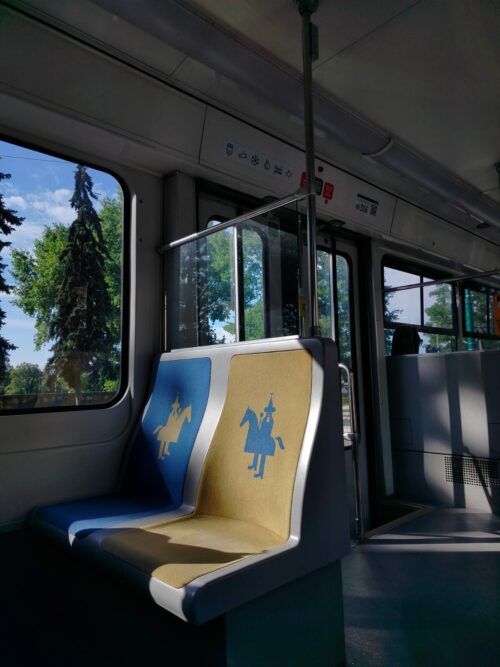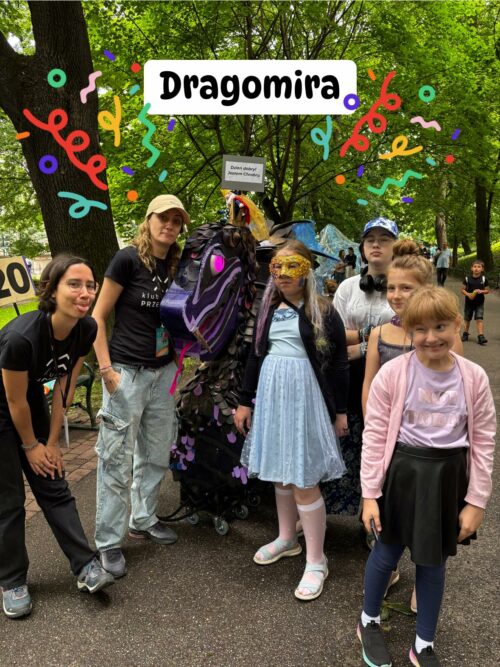Ever since we first arrived in Krakow we started hearing stories about the city legends and its famous characters, even if they changed from storyteller to storyteller (as stories should!). Soon the mysterious wizard-like figure on the tram’s seats was no longer unknown to us, neither the dragon under the Wawel castle nor all of the little sculptures scattered around the city. However, we were not yet aware of how alive all of these legends and traditions are still nowadays!
Summer is around the best time to get to know this first hand in Krakow, while also enjoying the warm weather and laid-back atmosphere.
At the end of June already there’s a chance to encounter the real Lajkonik on the streets and to take part in some of the summer solstice ancient rituals as well, on which Johanna and Emma definitely have a few stories to tell.
The Lajkonik first confused most of us: was it a knight? A wizard? A celebratory costume? Its image and name seemed to be everywhere, giving name even to one of the handier café-bakeries in the city.
According to the legend, the Lajkonik is reminiscent of the invasion of Tatars in the 13th century, when some of Wisla’s rafters contained the soldiers in the district of Zwierzyniec by killing their leader, whose clothes were then worn by a triumphant rafter to announce their victory. We can still see him on the parade taking place every Thursday after Corpus Christi, departing from Zwierzyniec and ending on the Market Square, accompanied by the carrier of a standard, twenty of the Wisla rafters and a band that livens up the march.


Then came all the summer solstice festivities! The most important within the Polish tradition here in Krakow is called Wianki and takes place the last Saturday of June or around the summer solstice. Although it used to maintain some of the ancient elements such as fortune telling, jumping over bonfires and letting wreaths float on water, it eventually became a mass cultural event including musical and theatrical performances and firework shows among other attractions.
However, some other festivals of Slavic origin also find their way into the present and are celebrated in Krakow, such as Kupala night.
Noc Kupały is basically the Slavic version of a magical summer party. It’s all about bonfires, flower crowns, and a dash of romantic fortune-telling. People jump over flames for “good luck”, float candlelit wreaths down rivers to see who they’ll marry, and go hunting for the legendary fern flower. Which, spoiler alert, doesn’t exist, but makes a great excuse to wander in the woods at night. These days it’s part ancient tradition, part festival fun, and still a perfect excuse to stay up till sunrise.

This year, Johanna and Emma went to Zakrzówek with friends and decided to fully lean into tradition. Apparently, if a couple jumps over the fire together and sticks the landing, it means they will have a happy, lasting relationship. Johanna didn’t have a date so she grabbed a friend and thought they could fake it. But the fire wasn’t buying it. At the reception of the jump, she lost her balance because of sticks on the edges of the fire and ended up on her butt. So… no great love story there, but they walked away with a ridiculous memory. And luckily, no evidence of it!

Then July was the time to take a look at the other great symbol of the city, Wawel’s dragon! Not only does it guard the Royal Castle and is present in a myriad of souvenirs from the city, but it’s also brought to life each year by dozens of institutions who create their own dragon and take part in a great parade that brings them to the Market Square to be admired and potentially awarded for their looks and creativity.
Celia had the opportunity to join the parade with Przegorzaly’s dragon, Dragomira! It was a lot of fun even if the weather didn’t really work out that well. Seeing how much effort and inventiveness other teams put into their dragons was inspiring although of course we still rooted for ours, who got a more than well deserved recognition by the jury! The night before, Miguel also learned about the Dragon’s legend by attending the incredible firework show and seeing the dancers and even jetskis in the Wisla river with some friends.
These are just some of the festivities and events taking place during the summer months, but there’s so much more to discover about Polish culture and folklore throughout the rest of the year: the Easter traditions, Christmas markets, national holidays… we challenge you to learn about and enjoy all of them!


